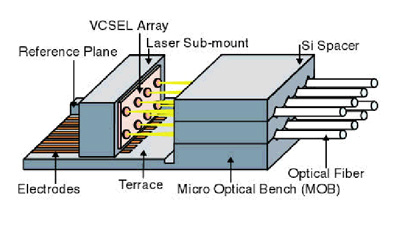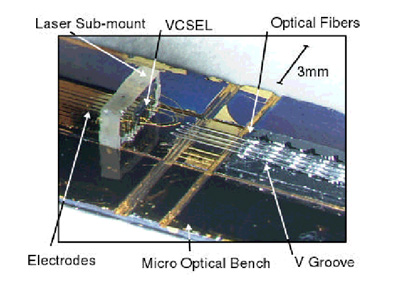Parallel optical transmission module uses VCSEL arrays

By Charles Whipple, contributing editor
A research team under the direction of Kenichi Iga at the Precision and Intelligence Laboratory at Tokyo Institute of Technology (Tokyo, Japan) recently demonstrated a parallel optical transmission module that incorporated a vertical-cavity surface-emitting laser (VCSEL) array and a micro-optical bench (MOB) to hold optical fibers. The team, headed by Yasuhiko Aoki, showed that parallel optical transmission is one solution for high-speed, large-capacity data transmission.
"The key device is the VCSEL array," says Yuji Shimada, a member of the team. "But the module must also contain 2-dimensional arrayed devices to act as optical couplers." The team's objective was to achieve alignment-free optical interconnection between the laser array and optical fibers, using a MOB. The experimental device Aoki's team devised was set up for two-by-four channel parallel optical transmission.
Inherently precise
The module consists of a 850-nm VCSEL array, an MOB, and multimode optical fibers. The MOB is formed with a silica substrate marked with V-grooves, reference planes, and terraces, which are designed to align the optical components and hold them in position. "Specifically, we use the reference planes to align the optical components laterally, and the terrace to align them horizontally," Shimada explained. "No other precision alignment is necessary, which makes our method quite unique."
The VCSEL array is located in a laser submount on a terrace that sets its height or horizontal position. Electrodes are formed on both the laser submount and on the positioning terrace. The solder bumps on the laser submount and MOB are used for wiring.


The VCSEL component butts against a reference plane that sets its lateral position. This lines the lasers up with the optical fibers that are clamped into the V-grooves of the MOB. The optical fibers' are located laterally on a pitch of 250 m and a horizontal pitch of 500 m (which eases manufacture of the spacer). The system is simple and effective.
A feasible approach
Shimada explains the advantages of the team's parallel optical transmission module. "First of all, no precision alignment is needed, yet we get efficient, effective optical coupling," he said. "Second, the two-dimensional aspects of the array make it easy to extend the concept to cover large transmission capacities. Third and perhaps most importantly, the simplicity of the fabrication should make this module easily mass produced."
The researchers measured the excess optical coupling loss between the laser array and the fibers used with the MOB--it was only approximately 0.5 dB compared to a precisely (actively) aligned module. "Our experiment proved that it is possible to produce a parallel
optical transmission module with a VCSEL array and MOB without precision alignment," said Shimada. "Moreover, we could not observe any noticeable performance degradation in the VCSEL array. We feel this is a completely feasible module."
About the author…
Charles Whipple is an independent journalist and consultant who resides in
Tokyo.
